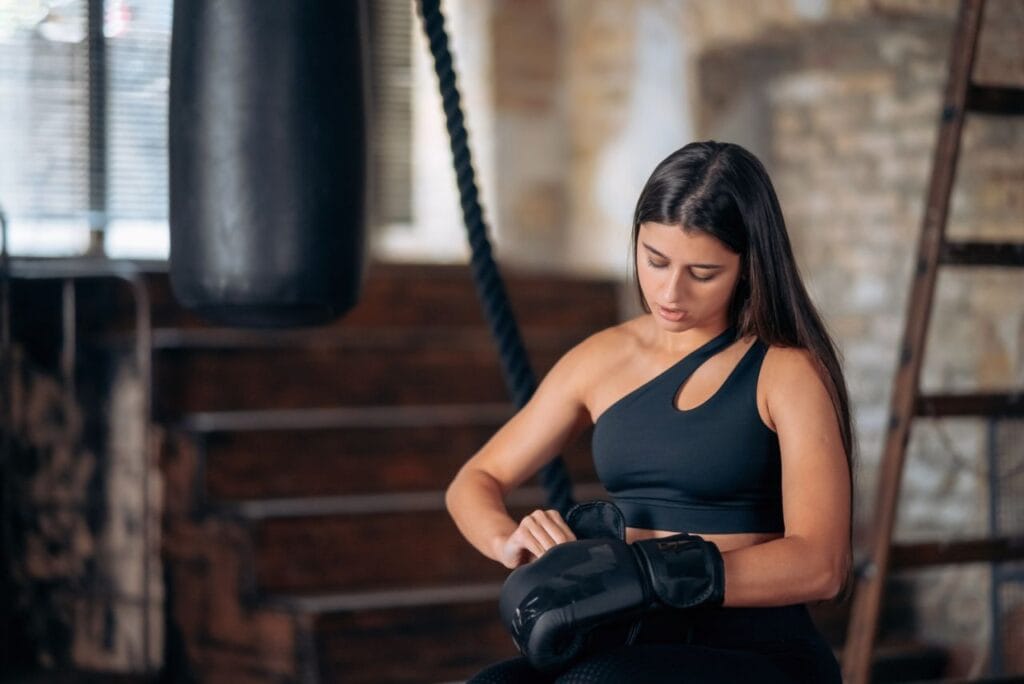The coronavirus pandemic has changed the way we do things. As physical contact is deemed dangerous, many businesses have closed or limited in-person capacity, with gyms being hit hard by these restrictions.
You may feel that you can no longer work out and exercise if the gym is closed, but there are many things you can do at home to compensate, like setting up an ideal home gym. If you are a student who is stuck at home on quarantine, try out these seven home workout tips from a boxing coach to help you stay fit.
Now that gyms are closed, and we all need to maintain a physical distance of six feet from others, we need to adjust our workout routines. As it turns out, many useful techniques can be adapted from boxing workouts.
We can come up with many reasons why we can’t go to the gym, with time being the number 1 reason. However, don’t let not going to the gym stop you from getting a workout in.
The beauty of boxing is that it can be performed nearly anywhere if you have some basic equipment such as gloves and a bag. Boxing can be challenging to master, but anyone can begin the basics with a few simple tools.
Boxing, with its rhythm of three-minute rounds followed by one minute of rest, has interval training built right in. Boxing workouts are no different. Walk into any boxing gym, and you’ll be greeted by the sound of a bell ringing, marking a schedule of work followed by rest.
Meanwhile, boxers’ strength and conditioning workouts use minimal equipment and can easily be adapted for small spaces.
Boxing Fundamentals For Beginners
Boxing is having a mainstream moment, but you don’t need to go to a special gym to try it: You can do this beginner boxing workout at home using just your body weight.
Among the many benefits of boxing, the martial arts workout blasts up to 600 calories an hour while sculpting your arms, shoulders, core, and legs. And since nailing the punch sequences requires extreme focus, boxing is an excellent way to train your mind and body at once.
Basic Boxing Form
Keeping your form and technique sharp is important as you learn how to box. Not only does this help protect you from injuries, but it also allows you to land a good punch over and over again with more efficiency and strength.
Learning to box by starting with your basic boxing form helps connect you to your foundation. Every pivot, extension, and rotation comes from that foundation, and if you can tap into that, then no one can touch you in or outside the ring!
That’s why practising the basics is a necessary part of boxing, whether you are throwing your first punches or you’ve been boxing for years.
Stance
It’s important to first start with your boxing stance because it is the starting point for all your punches. If you are right-handed (an Orthodox boxer), you will start with your left foot forward and your right foot back.
If you are left-handed (or a Southpaw boxer), you will start with your right foot forward and your left foot back. This stance positions your dominant hand farther back so you can line up a punch with maximal power.
Bring your hands up to your chin to protect your face, tuck your chin slightly down, and keep your shoulders soft. Stagger your stance at about hip-width distance to be balanced, and your weight is distributed.
Footwork
In your boxing stance, bend your knees, straighten your spine, and push off the ball of your foot with every movement. There should be a bounce to your body in your boxer stance, ready to move at any moment.
This is because you are never static in boxing. You are always moving. After all, you never want to be a sitting duck for your opponent (even if your opponent is Liteboxer!).
To float like a Muhammad Ali butterfly, it’s important to practice drills like jump roping, defensive movements like bobbing, rolling, and weaving, quick side shuffles, or taking small bouncing steps in your boxing stance so you can get comfortable being light on your feet.
Then, every time you punch, practice snapping back to your boxer stance as quickly as you can.
Punching
There are four basic punches in Liteboxer boxing: the jab, straight cross and left and right uppercuts.
While in your boxing stance, your dominant hand will deliver a rear cross and rear uppercut punches, while your non-dominant hand will deliver lead jab and lead uppercut punches.
When punching with your dominant hand, use your back leg to power your punches. When punching with your non-dominant hand, use your front foot to step forward.
When you throw your dominant hand punches, you’re going to pretend like you are crushing a grape under your back toe. Instead, pick up your back heel and twist from your hips to generate more power.
Make sure to keep your punches tight. If you overextend your arm, swing out with your elbow too wide, or uppercut past your nose, you lose precious energy. After you punch, don’t forget to step back to your boxer stance immediately.
Six Basic Punches
Before you get started working through the boxing moves, Lavinia demonstrates six basic punch techniques. Keep your knees bent and stay on the balls of your feet as you move throughout these punches:
Jab: Your front hand will come forward into a straight punch, with your thumb facing the floor. Your backhand will remain up in starting position, with your elbow tucked to your ribcage and your fist near your chin. Reset by returning your front hand to starting position.
Cross jab: Like the jab, the cross involves extending your backhand forward in front of your face. This time, twist your body to bring your backhand forward, pivoting your body. Reset by returning your backhand to starting position.
Front hook:
- Bring your front arm around in a hook-like shape.
- Pivot your front foot as you turn your hips inward and cross your arm over.
- Bring your front arm back to reset when your elbow aligns with your shoulder.
Back hook: Pivot your back foot as you make the same hook-like shape with your back arm. Turn your back hip inward as you flow through the motion; once your elbow aligns with your shoulder, bring your arm back in to reset.
Front uppercut: Bring your arm in a similar, hook-like position, but drop your front arm and bring it back up towards you, rather than around in front of you. Keep your palm facing your torso.
Back uppercut: Bring your back arm down and around with the same stance as the front uppercut. This time, pivot your back foot and twist your hips forward as you send your back arm to the front of the room.
Safety And Precautions
Before you begin, we advise that everyone box at their own pace. “It’s easy to get caught up in trying to throw fast punches. I get it—it looks and feels fantastic. However, it would help if you moved slowly and intended to learn and maintain the proper form and technique. Once you have nailed that, you can pick up the tempo.
She says another important thing to remember is to breathe. So often, when we try to do something new, we tend to hold our breath. “Use the power of your breath to throw stronger punches. Exhale, and you throw your punch.”
Warm-Up: Jump Rope
3 minutes
Jumping rope is an iconic boxing drill for a good reason. It combines cardio, coordination, agility, and footwork all in one exercise.
Jumping rope is all about timing and rhythm. The lightning speed and cool tricks achieved by advanced boxers come with plenty of practice. Beginners should incorporate jump rope exercises and drills into their training regularly.
Get your blood pumping with this traditional boxer’s warm-up. Use a real jump rope if you have one handy, but if not, imagine you’re holding one.
Jab, Cross, Jab, Bob and Weave

Reps: 10 per side
A. Stand with your right foot forward, arms in “guard” position (elbows bent, hands in fists on either side of your chin). Throw a right jab (quickly punch your right arm forward, rotating your fist down, without locking out your elbow), a left cross (punch your left arm forward, rotating your left hip into the punch and lifting your left heel off the floor), and then repeat a right jab.
B. Bring arms back to guard, and quickly bob and weave from left to right by lowering into a squat as you circle your body from the back (lower left) to the front (lower right), as if tracing a letter “U” with your upper body). Return to start. That’s one rep.
Do ten reps in a row as quickly as you can, and then switch your stance and do ten reps on the other side.
Boxer Push-up
Push-Ups might seem basic, but they are one of many boxers’ favourite exercises for a reason. Push-Ups are a compound movement, which means they engage multiple muscle groups simultaneously.
So, for example, you effectively engage your triceps, pectoral muscles, shoulders and lower back and core muscles with one Push Up.
Round 1: Boxer Push-Ups
Reps: 10
A. Start in a plank position with hands directly below shoulders, core engaged.
B. Lower body until chest is just a few inches above the floor.
C. Press halfway up, then lower back to hover above the floor.
D. Press back up to full plank. That’s one rep.
Jab, Cross, Hook, Bob and Weave
Power Right Cross
The cross is one of the most powerful punches in boxing. It’s the first power punch beginners learn to execute right after learning how to throw the jab.
Because it naturally transfers power from the base right down to the end of the fist, the cross is an effective knockout blow that can be utilized in many situations.
Get in a proper boxing stance. For example, get the right distance to land a right cross (or left cross) if you’re a southpaw. Throw it with full power, like you’re trying to knock someone out and try to land it at the height of your chin.
Then quickly get your hand back on your cheek. After you do that, make 2-3 small steps to your right or the left (like when fighting and circling the opponent), then stop and throw another powerful cross. Do this for 2 minutes. Then rest for 40 seconds. Repeat the exercise 4 times.
Body uppercuts
This exercise is very similar to the previous one – you need to go full power. But this time, we are going to work on body shots. Let’s go through the steps:
- Get in your stance and get closer to the bag
- Keep your hands up – do a high guard
- Keep your knees slightly bent and use them when punching to add more power to the blow
- Get close to the bag. This time we’re going to fight from the inside – close to our opponent
- Throw combinations of powerful left and right uppercuts. You can alternate or throw double left or right uppercuts
- Bob and weave and slip punches all the time – imagine your opponent trying to counter every attack
- Keep the right hand up when throwing left uppercuts and vice versa
- Circle around the bag between the combinations
Do three sets of this exercise for 2 minutes each and rest for 40 seconds between the sets.
Core exercises
- 30 seconds sit-ups
- 30 seconds leg raises
- 30 seconds mountain climbing
- 30 seconds plank on forearms
- Rest 40 seconds
Repeat the same thing two more times, and rest 40 seconds between the sets
Warming Down
Good job, you’ve done the hard work. Now it’s time to warm down. We are going to do it by jumping rope. This exercise will not only help your muscles to warm down, but it will also improve your boxing footwork.
Jumping rope (200 times)
If you’re a beginner and can’t jump properly yet, you can try doing the first 50 without a rope (jump on your toes).
For then, do the next 50, grab a rope in your hand and start just swinging it (without actually jumping over it). Again, try to time it when jumping.
The last 100 jumps you can do by jumping slowly with frequent breaks. For example, your first goal will be to make five jumps, then 10, then 15 and so on.
FAQs
Is Home Boxing Good Exercise?
A boxing workout at home is a great option for an effective 15-minute workout. Boxing works with multiple muscle groups to help you strengthen and tone your body. It is also a great cardio workout because it spikes your heart rate, so you burn more calories and fat.
Furthermore, the best short workout is one that can have you reap the same benefits as a longer workout in a shorter time frame. An anaerobic workout like boxing is a high-intensity workout that burns fat in a shorter time than a traditional aerobic workout.
Boxing is a great stress reliever and a perfect outlet to let out any built-up aggression.
How Can I Practice Punching Without A Punching Bag?
- How to Punch Harder Without a Punching Bag
- Use a punching bag substitute.
- Practice punching with your whole body.
- Punch slowly.
- Exhale as you punch. Breath out from your chest and stomach hard and fast when your punch comes out.
- Punch straight, not curved.
- Perform punching drills.
Do Push-Ups Improve Punching Power?
Push-ups can help build punching power. In a plyometric workout, limit the number of repetitions you do because the exercise will tax your muscles. You can still do two, three or four sets of explosive push-ups during your workout but limit the number of repetitions in each set to five to 10.
If your form starts to break down, or if you start to feel significantly slower, then you should stop the set because explosive push-ups should be done as fast as possible.
Can Boxing Be Self Teach?

With better technology, low-cost equipment, and access to video, many people are turning away from a gym and teaching themselves how to box instead.
So, can boxing be self-taught?
Boxing can be self-taught, but it’s not the quickest and most effective way to become better at the sport because you aren’t able to tap into the knowledge of a boxing coach who would help you one to one.
Is Boxing Hard To Learn?
Boxing is easy to pick up but hard to master. Many people go into training not knowing what to do, and if they aren’t taught the right techniques, they can develop bad habits that are hard to get rid of.
Learning how to box isn’t just about getting the movements down. It’s also about knowing what goes behind each movement that will ultimately make a difference.
There’s a reason why boxing is known as “The Sweet Science”, and it’s because there’s so much of it to study. Avoid making beginner mistakes and fast-track your development into a seasoned veteran.
- Find a gym. Boxing gyms aren't typically found in the yellow pages, but there are resources on the internet that can lead you in the right direction. ...
- Be sure the gym is within striking distance. ...
- Be open-minded. ...
- Choose your coach carefully. ...
- Do judge the gym by its cover.
So, can boxing be self-taught? Boxing can be self-taught but it's not the quickest and most effective way to become better at the sport because you aren't able to tap into the knowledge of a boxing coach who would be able to help you one to one.
Best Age to Start
Specialists in sports medicine believe that boxing classes are better to start from 9-10 years. Starting too early could result in putting the student off, as boxing is hard work and not always as fun as team sports, such as football or rugby.

